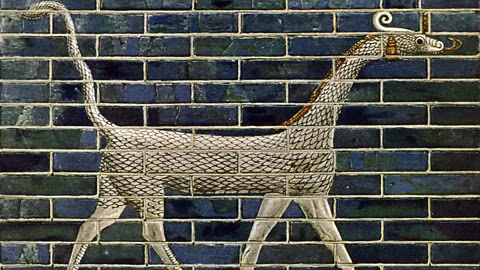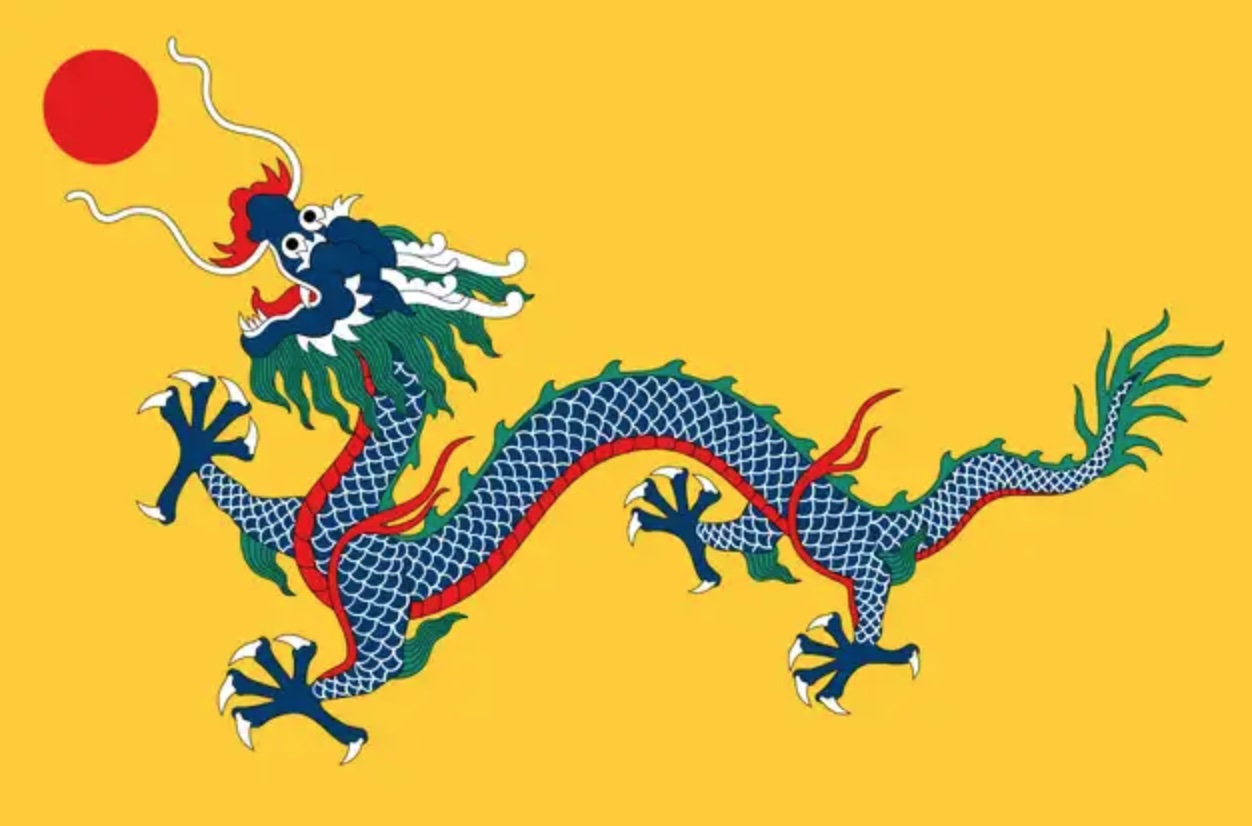Ask Language Log: Manchu Blue Dragon
« previous post | next post »
Continuing our series on dragons, this note and illustration come from Juha Janhunen, the Finnish linguist:
Happy Blue Dragon Year to everybody! Below is the official flag (1889-1912) of the Manchu Empire (in the west misleadingly known as "China"), which happens to have a blue dragon on it. Manchu muduri 'dragon' still seems to lack an external etymology. Any suggestions?
(See at the very bottom of this post for a possible connection to "otter".)
We still have much ground to cover relating to dragons, e.g., long gu* ("dragon bones", as used in TCM [Chinese materia medica], mythology, linguistic aspects, etc.)
—
*For the last two millennia, these fossil remains were thought to be the bones of dragons, and they were ground up into powder and used as a part of Chinese pharmacopoeia. This was true right up till their scientific study began in the late 19th-early 20th century, when people started to use them for paleographic research, viz. "oracle bones".
Selected readings
- "What is the difference between a dragon and a /lʊŋ³⁵/?" (2/10/24)
- "A (troop / troupe of) dragon(s) tromping / flying" (12/4/23)
- "Horse conquers dragon" (1/10/18)
- "Viral pushback against the imperial dragon in a dragon year) (1/29/24)
- "Heirs to the dragon / cage" (5/26/20)
- "Happy LÓNG year!" (1/24/12)
- Robert Blust, "The Origin of Dragons", Anthropos, Bd. 95, H. 2. (2000), pp. 519-536 (18 pages)
Abstract
This paper addresses a question that has puzzled scholars for more than a century: "Why is a belief in dragons found over much of the earth?" It argues that dragons evolved from rainbows through the concept of the rainbow serpent, a concept that itself extends far back into the Pleistocene. In this perspective many seemingly arbitrary traits which are widely associated with dragons are seen to have a physical explanation.
- Future Planet team (reporting by India Bourke, Katherine Latham and Sophie Hardach), "Wise, lucky, terrifying: The surprising 4,000-year history of dragons", BBC (2/8/24) — Highly informative, up-to-date article that is especially interesting from the standpoint of dragon related terminology in diverse languages: Sumerian ušum-gal (lit., "snake big"); Akkadian mušhuššu (loaned from Sumerian muš huš (lit., "fierce snake"), this creature is translated "dragon" and is famously depicted on the Ishtar Gate from Babylon"; Mandarin lóngjuǎnfēng ("tornado" [lit., "swirling-dragon-wind"]); etc.
In AD793, "fiery dragons" soared across Northumbrian skies – a bad omen. A vicious and devastating Viking raid followed on the northern English island of Lindisfarne, sending shockwaves across Europe.
Anglo-Saxon stories are rife with ferocious dragons, slumbering in dens beneath hills, guarding their treasure. The legends live on in many English place names. Take Dragley Beck, a hamlet in Lancashire, and Drakelow, a village in Derbyshire. Both could mean "dragon's mound", or "dragon-hill".
Historically, English has two common words for dragon: dragon, and the now rarely-used, ancient word wyrm. The word "dragon" is derived from the Latin "draco" meaning serpent, or sea fish. Meanwhile, in Christian religious texts, "dragon" also referred to the devil. This mythological creature took on different qualities and shapes throughout history, for example as a fire-breathing dragon called a "firedrake".
"Wyrm", on the other hand, is a slithering, crawling creature, not a winged, flying, fiery one one. "Wyrm" also referred to parasites, snakes and grave-dwelling creatures in early medieval England. It inspired myths such as that of the child-eating Lambton Worm. This creeping creature was more common in English folklore than the winged version, and lurked in caves, marshes or fens.
"The wyrm has no legs, but slithers like a serpent," says Carolyne Larrington, professor of medieval European literature at the University of Oxford. It is different from the fiery, winged monsters: "The firedrake can fly and shoot flames," Larrington adds, "while the wyrm spits poison".
Real-life snakes, says Larrington, may have inspired the myths. "People have [also] suggested that dinosaur fossils might have played a part. But there's no real correlation between dragon stories and fossil finds," she says. A snake-inspired myth may have made its way to England from abroad: there is some evidence that the dragon motif has migrated with the movement of humans.

A mythological dragon creature called "mušhuššu" in Akkadian, depicted on the Ishtar Gate from Babylon (Credit: Getty Images)
Back to Manchu muduri "dragon": The case of the otter
Reconstruction: Proto-Tungusic/muduri
Etymology
From *mudu- (“to gnaw, bite”) + *-ri.
Noun
*muduri
Descendants
Thus in Tungusic languages, we see a crossover between "dragon" and "otter".
In Norse mythology, Ótr (Old Norse: [ˈoːtz̠]; alternately: Ott, Oter, Otr, Ottar, Ottarr, Otter) is sometimes confounded with dragons.
aquatic digitigrade carnivorous mammal, hunted for its fur, Middle English oter, from Old English otr, otor "otter," from Proto-Germanic *otraz "otter" (source also of Old Norse otr, Swedish utter, Danish odder, Dutch otter, Old High German ottar, German Otter), from PIE *udros, literally "water-creature" (source also of Sanskrit udrah, Avestan udra "otter;" Greek hydra "water-serpent," enydris "otter;" Latin lutra, Old Church Slavonic vydra, Lithuanian ūdra, Old Irish odoirne "otter"), from root *wed- (1) "water; wet." The sea otter, marine otter of the U.S. Pacific Northwest (distinguished from the land- or river-otter) is attested from 1660s, also known as sea-ape.
From Middle English oter, otir, otur, otyre, from Old English otor, from Proto-West Germanic *ot(t)r, from Proto-Germanic *utraz, from Proto-Indo-European *udrós (“aquatic, water-animal”), from Proto-Indo-European *wed- (“water”).
Cognate with Saterland Frisian Otter, Dutch otter, German Otter, Swedish utter, Norwegian oter, Icelandic otur, Sanskrit उद्र (udrá), Russian вы́дра (výdra), and Ancient Greek ὕδρα (húdra, “water snake”). Doublet of Hydra and hydra. More etymology under English water.
I am not asserting some such phonological process as the nasalization or denasalization of the initial of either Manchu muduri or suffixed zero-grade form of IE wed- *ud-ro-, *ud-rā- ("water animal"). I simply am pointing out the curious morphological and semantic coincidence between the words for "dragon" and "otter" in the two languages.

loonquawl said,
February 14, 2024 @ 2:16 am
Just wanted to chime in with a clear geographic correlation of the word "dragon" and fossil bone finds: the 'Drackensteiner Hang' (Dragon stone slope) near the Drachenlochbrücke' (Dragon Hole Bridge), both located very near a famous fossil-finding site. 'https://de.wikipedia.org/wiki/Drachenlochbr%C3%BCcke https://www.urweltmuseum.de/
Lasius said,
February 14, 2024 @ 3:32 am
That's weird. Otters are plantigrade.
Interestingly Otter – "otter" and Otter – "adder" (itself a doublet of Natter – "colubrid") are homonyms in German.
Chris Button said,
February 14, 2024 @ 9:41 am
I've always felt 獺 "otter" with its confused readings is a good candidate (when reconstructed properly) as a loan from the Indo-Aryan reflexes noted above.
David Marjanović said,
February 14, 2024 @ 1:54 pm
Also for paleontological research. For example, Gigantopithecus was discovered on a dragon-bone market, and so were various dinosaurs.
I'm surprised you consider "contains u, d and r in this order" even worth calling a coincidence.
Victor Mair said,
February 14, 2024 @ 2:24 pm
when combined with having the same semantics
Yves Rehbein said,
March 2, 2024 @ 7:19 pm
Quite similar to otter < *wod-r-o: Roman Garnier argues that Ancient Greek βάτραχος "frog" may be a Thracian borrowing and be derived from *wed-, that is *wod-r-o-kó "l'animal qui vit dans l'eau" (Scripta Selecta, p. 51).
Perhaps it's possible to connect the biblical Basilisk "adder" like so: it translates Hebrew tsepha`, the root supposedly denotes a "hiss". A few animal names begin with ‹ts›, including tsephardea, the frogs known as one of the biblical plagues. And if I remember correctly, Greek ‹s› can reflect an assimilated dental.
Chances are that this is a coincidence, of course.